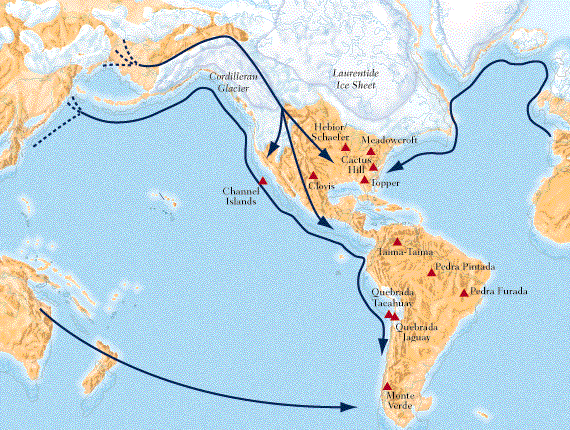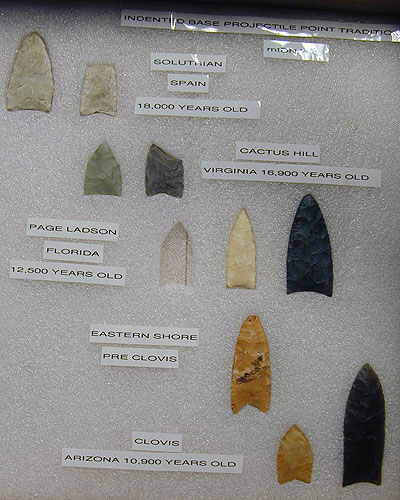Many scientists believe that prehistory in the Southeastern United States began some 20,000 to 30,000 years BP in the frozen tundra of Siberia in northeastern Asia. During the last twenty years, Paleoindian lithic research in the former Soviet Union has revealed a series of new sites containing cultural horizons of the middle and lower Pleistocene and Eopleistocene eras.[i] The lithic components of these sites consisted of unifacial pebble scrapers and choppers. Several newly discovered sites in northern China dating to 35,000 years BP, exhibit similar lithic traits. Fossil remains excavated at the later sites confirm that the people of that day were nomadic hunters who banded together to follow herds of megafauna including the mastodon, woolly mammoth, mammoth rhinoceros, horse, giant sloth, camel, musk-ox and bison.[ii]
From their entrance into the new world, the migration of Paleoindian people carried them eastward and southward into every corner of the Americas including what is now the continental United States (Map 1A).

Over the last 20 or so years, this basic understanding of the peopling of the Americas has been challenged.
The American continent was the last of the world’s continents to be populated. There are many contradictory and more or less well-founded scientific theories on when this occurred and where the first immigrants migrated from. The prevailing theory is based on findings of stone tools from the Clovis culture in soil layers dating back to approximately 13,000 BC. According to the theory, people from Siberia migrated, perhaps in search of mammoth, across the land bridge that once connected Siberia and North America. From there, they continued south and spread out across the American continent. The migration passed through a corridor that opened up approximately 14,000 years ago in the giant glacier that covered the American continent.
New findings call this immigration theory into question: Professor Eske Willerslev of the University of Copenhagen was surprised by the results of the DNA tests on samples of what turned out to be fossilized human feces found in deep caves in the Oregon desert. The oldest of the droppings have been carbon-dated to be approximately 14,340 years old. Willerslev’s feces samples clearly contain two main genetic types of Asian origin that are unique to present-day North American Indians. Not only is this proof that the American Indians are descendants of the first immigrants to the continent, it is also proof that immigration took place approximately 1,000 years earlier than otherwise believed.
The Solutrean hypothesis is an alternative theory about the settlement of the Americas, according to which peoples from Europe may have been among the earliest settlers of the American continent. The theory that is currently most widely accepted, and which is supported by genetic, linguistic and archaeological evidence, considers the American continent to have been populated from Asia either via the Bering land bridge or by sea. The Solutrean hypothesis was first proposed in 1998. Its key proponents include Dennis Staniford, of the Smithsonian Institution, and Bruce Bradley, of the University of Exeter.
According to this hypothesis, people associated with the Solutrean culture migrated from Ice Age Europe to North America, bringing their methods of making stone tools with them and providing the basis for the later Clovis technology found throughout North America. The hypothesis rests upon proposed similarities between European Solutean and Early American Clovis lithic technology. Many archaeologists have criticized the proposed similarities as too insignificant and just as likely to be due to chance as to shared origins. As one has said, “few if any archaeologists — or, for that matter, geneticists, linguists, or physical anthropologists — take seriously the idea of a Solutrean colonization of America.”
Though the proponents cite recent archaeological findings in support of the theory, the hypothesis has generally not been well received. A recent DNA study challenges a genetic argument often made in favor of the hypothesis. The study argues against the apparently anomalous mtDNA Haplogroup X2A having migrated to the Americas via an Atlantic route.

Solutrean culture was dominant in present-day France and Spain from roughly 21,000 to 17,000 years ago. It was known for its distinctive tool-making characterized by bifacial, percussion and pressure-flaked points. Traces of the Solutrean tool-making industry disappeared almost completely from Europe around 15,000 years ago, when it was replaced by the stone tools of the Magdalenian culture.
Clovis tools are typified by a distinctive type of spear point, known as the Clovis point. Solutrean and Clovis points share common characteristics: points are thin and bifacial, and they share the intentional use of the “outre passé”, or overshot flaking technique, which quickly reduces the thickness of a biface without reducing the width.
The Clovis blade differs from the Solutrean in that some of the former have bi-facial fluting (a long depression that occurs on a point, struck from the basal end of the point; the purpose was to better fit the point onto a spear foreshaft). Clovis tool-making technology seems to appear in the archaeological record in eastern North America roughly 13,500 years ago, and similar predecessors in Asia or Alaska, if they exist, have not been discovered.
Stanford and Bradley, in their book “Across Atlantic Ice,” make a variety of claims in support of the Solutrean hypothesis. Among these are the connection between the Clovis culture and several artifacts found in Maryland, Pennsylvania, Virginia and Delaware. In addition, they have been able to carbon date many new findings from the Delmaria Peninsula in Maryland to between 26000 and 19000 BC, which is contemporary with the period in Europe during which similar artifacts were being made. According to their book, no materials from before 15,000 years ago, of any make or cultural bearing, have been found on the West Coast near where the first Siberian ancestors of American Indians first arrived.
The hypothesis proposes that Ice Age Europeans could have crossed the North Atlantic along the edge of the pack ice that extended from the Atlantic coast of France to North America during the last glacial maximum. The model envisions these people making the crossing in small watercraft, using skills similar to those of the modern Inuit people, hauling out on ice floes at night, getting fresh water by melting iceberg ice or the first-frozen parts of sea ice, getting food by catching seals and fish, and using seal blubber as heating fuel. Among other evidence backing up this hypothesis is the discovery among the Solutrean toolkit of bone needles, very similar to those traditionally used by the modern-day Inuit. As well as enabling the manufacture of waterproof clothing from animal skins, the technology could, in theory, have been used to construct kayaks from the same animal skins. However, a 2008 study argues that the conditions were not favorable for such a crossing.
The discovery of pre-Clovis remains at sites like Page/Ladson, located along Florida’s Aucilla River, was reported by Jim Dunbar. Seven radiocarbon dates taken from Unit 3 of that site had an average date of 14,245 years before present (BP). The lanceolate blades made on thin flakes, which have been named the Page-Ladson point, bear strong similarities to the pre-Clovis points found at the Cactus Hill site. The Cactus Hill site in Virginia dates between 15,000 and 17,000 years BP. These discoveries, and the Topper site near Allendale, South Carolina, have strongly suggested a relationship to European lithic technology. The Clovis culture at the Topper site and the pre-Clovis culture beneath it that dates much earlier have yielded evidence of a possible relationship to the Solutrean culture of southern France that dates between 18,000 and 20,000 years BP. The thinly fluted blades of the Clovis culture bear little resemblance to the thick, heavy blades of the Siberian Dyuktai points that date to only 14,000 years BP. These relationships may suggest a migration route from northern Europe along the edge of the glacial face to North America. Perhaps the Vikings of a thousand years ago were not the first Europeans to set foot in the Americas after all.
Since 1960, archaeological studies of the river basin projects in the Southeast as well as statewide studies of Paleoindian point finds and site distribution, have led to refinements in the sequencing of point types and attempts to reconstruct Paleoindian cultural activities. Excavations at Paleoindian sites, better dating techniques, the study of the distribution of Paleoindian point types, and the study of the Late Pleistocene environment have led archeologists to develop a new model for Paleoindian occupation in the Southeast that is now broken down into three subperiods between 11,500 and 9,900 years BP.
[i] Ranov, V.A., The Loessic Paleoindianlith: A New Paleoindianlithic Terminology, Current Research In The Pleistocene, Americas Publication Vol. 4, 1987
[ii] Shum, Dee Ann, Krieger, Alex D., Jelks, Edward F., An Introductory Handbook of Texas Archaeology, Bulletin of the Texas Archaeological Society, Vol. 25,1954